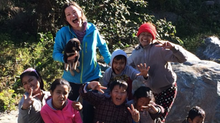Trinidad's Blog
- grain40
- Feb 10, 2014
- 3 min read
The Healing Stitch
It’s been a month since I started volunteering at Bhotechaur Hospital in Nepal. Since this hospital is located in a rural area, most of the patients that come to our hospital are farmers that travel between 1 to 4 hours to get some help with their complaints. Mostly all of them come with musculoskeletal disorders, knee pain being the number one complaint. Paresthesia, gastric pain, stroke, paralysis and respiratory disorders are also commonly seen in the clinic. Wandering around the fields and visiting their homes, its easy to understand why mostly all the patients suffer from this conditions: they carry all the weight with baskets that hangs with belts from their heads, which is probably the cause of most of the cases of headache, paresthesia and even knee pain; they spend long hours working on the rice fields with theirs knees bended and arched backs; to cook, they burn wood and other materials inside the house without proper ventilation, explaining the high rate of COPD in rural Nepal; being invited to their homes I’ve had the luck to enjoy some delicious and VERY VERY spicy vegetables, which clearly explain why they suffer from burning epigastric pain.
When treating patients, cultural differences and communicational barriers can be very challenging, nevertheless it’s been an amazing experience to improve and expand my knowledge in other skills that are so useful in the clinic, like observation and channel palpation. In this context I’m extremely grateful for having the chance to learn with Dr. Wang Yu-Ji and his incredible team. Being here has made me appreciate and value even more and more all their knowledge; channel palpation has been an incredible tool for diagnosis and treatment in a place where I’m not able to communicate directly. Although sometimes they think I’m crazy because I’m palpating and asking about areas far away from the location of their chief complaint, little by little I have found ways to explain that by doing this I’ll be able to offer a better treatment for their condition. Sabina, our translator, has been incredibly helpful to transmit this to the patients.
Although most all of the patients have chronic conditions and a great amount of them are over 65 years old, the results has been amazing. The word “dhukhaena”, which means no pain, makes my day and thankfully I get to hear it very often!!! Is incredibly rewarding to see that these chronic, and sometimes elderly patients respond so well to treatment. Their pain decreases and mobility increases very fast, showing significant improvement within a few treatments even though their bodies are inevitability over-strained.
But treating patients is not the only thing we do with needles here! Recently, I discover that I could share my new passion for knitting with the staff. After seeing their enthusiasm I went to Kathmandu and came back equipped with needles and yarn to start a knitting workshop! Although I’m not really highly skilled at it, I’ve been teaching them basic stitches so they can start their own projects. This has been a very nice way to communicate and share with them without needing to relay exclusively in verbal communication. Sometimes there are women who don’t even speak English, nevertheless we can all enjoy, laugh and share through the language of knitting. Compassion, love, suffering, happiness and… knitting are spaces where we are all just humans sharing as equals. It’s very rewarding to find these spaces where cultural difference and language barriers are dissolved.
I feel absolutely blessed by this experience and by the warmness of the Napali people. I’ve been about to cry many times, but out of gratefulness and happiness for how lucky I am! Nepal is a country with a lot of education, health and infrastructure needs. I encourage anybody with creativity and compassion to join this initiative. Rewarding experience guaranteed!












































Comments